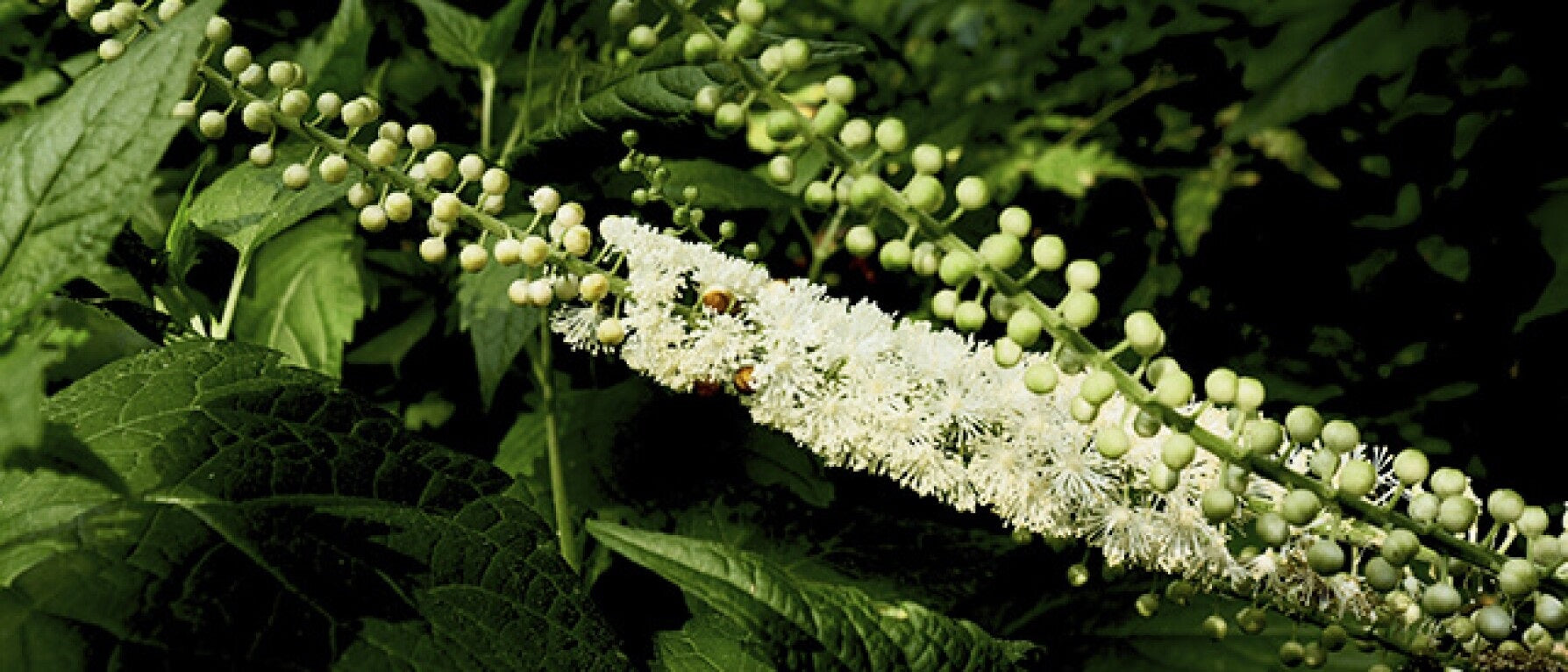Black cohosh (cimicifuga racemosa) is a native North American plant that has been used for thousands of years by Native Americans to treat women’s health issues, as well as other conditions.
A member of the buttercup family, black cohosh is a perennial shrub with serrated leaves and clusters of tiny white flowers. Herbal preparations are made from the plant’s roots and rh
izomes, which contain a number of glycosides, flavonoids, and terpenes. Black cohosh is widely available in health food stores in tablet and tincture form.
Other common names for the herb include black snakeroot, bugbane, bugwort, rattleroot, rattletop, and rattleweed.
Black cohosh is frequently used as an alternative to hormone replacement therapy, and some studies suggest that the herb acts as phytoestrogen, binding to estrogen receptors and influencing the release of pituitary hormones. In some people, black cohosh acts similar to estrogren, and has a similar effect on the body.
Black cohosh may also be effective in treating a number of other conditions, including arthritis, high blood pressure, osteoporosis, asthma, and joint pain.
Although teas are used traditionally, research shows that teas may not be as effective in relieving menopausal symptoms as black cohosh tincture or extract. To make a black cohosh drink, put 20 grams of dried root in 34 ounces of water. Bring it to a boil and then simmer it for 20 to 30 minutes until the liquid is reduced by a third. Strain, cover, and store in the refrigerator or a cool, dry place. The liquid will keep for up to 48 hours. Drink 1 cup three times a day.
As with any supplement, only take black cohosh under the supervision of your health care practitioner. Some people who take high doses of black cohosh report side effects such as diarrhea, abdominal pain, shortness of breath, dizziness, headaches, joint pains, nausea, slow heart rate, vomiting, and weight gain. Because of its potential stimulating effect on the uterine muscles, black cohosh is not recommended for women who are pregnant. Women with a history of breast cancer, and those who are at high risk of developing breast cancer, shouldn’t take black cohosh without first consulting with their health care practitioner.
*Editor’s Note: The information in this article is intended for your educational use only; does not necessarily reflect the opinions of the Chopra Center's Mind-Body Medical Group; and is not a substitute for professional medical advice, diagnosis, or treatment. Always seek the advice of your physician or other qualified health providers with any questions you may have regarding a medical condition and before undertaking any diet, supplement, fitness, or other health program.
A member of the buttercup family, black cohosh is a perennial shrub with serrated leaves and clusters of tiny white flowers. Herbal preparations are made from the plant’s roots and rh
izomes, which contain a number of glycosides, flavonoids, and terpenes. Black cohosh is widely available in health food stores in tablet and tincture form.
Other common names for the herb include black snakeroot, bugbane, bugwort, rattleroot, rattletop, and rattleweed.
Potential Healing Benefits
Although the results of scientific studies have been mixed, some researchers have found that black cohosh is effective in alleviating both the physical and psychological symptoms of menopause, including anxiety, vaginal dryness, and hot flashes. Other studies have shown that the herb is useful in treating the premenstrual discomfort provoked by hormonal changes, including irritability and depression.Black cohosh is frequently used as an alternative to hormone replacement therapy, and some studies suggest that the herb acts as phytoestrogen, binding to estrogen receptors and influencing the release of pituitary hormones. In some people, black cohosh acts similar to estrogren, and has a similar effect on the body.
Black cohosh may also be effective in treating a number of other conditions, including arthritis, high blood pressure, osteoporosis, asthma, and joint pain.
Black Cohosh and the Doshas
Black cohosh contains the bitter and pungent tastes and has a cooling effect on the body. Black cohosh can balance both Pitta and Kapha. However, prolonged use may aggravate Vata dosha.How to Take Black Cohosh
Recommended doses of black cohosh range from 20 to 80 milligrams per day.Although teas are used traditionally, research shows that teas may not be as effective in relieving menopausal symptoms as black cohosh tincture or extract. To make a black cohosh drink, put 20 grams of dried root in 34 ounces of water. Bring it to a boil and then simmer it for 20 to 30 minutes until the liquid is reduced by a third. Strain, cover, and store in the refrigerator or a cool, dry place. The liquid will keep for up to 48 hours. Drink 1 cup three times a day.
As with any supplement, only take black cohosh under the supervision of your health care practitioner. Some people who take high doses of black cohosh report side effects such as diarrhea, abdominal pain, shortness of breath, dizziness, headaches, joint pains, nausea, slow heart rate, vomiting, and weight gain. Because of its potential stimulating effect on the uterine muscles, black cohosh is not recommended for women who are pregnant. Women with a history of breast cancer, and those who are at high risk of developing breast cancer, shouldn’t take black cohosh without first consulting with their health care practitioner.
*Editor’s Note: The information in this article is intended for your educational use only; does not necessarily reflect the opinions of the Chopra Center's Mind-Body Medical Group; and is not a substitute for professional medical advice, diagnosis, or treatment. Always seek the advice of your physician or other qualified health providers with any questions you may have regarding a medical condition and before undertaking any diet, supplement, fitness, or other health program.

